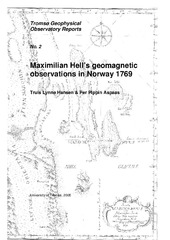Tromsø geofysiske observatorium: Nye registreringer
Viser treff 21-40 av 42
-
Nordlysets årsak
(Journal article; Tidsskriftartikkel, 1980)Nordlys dannes av gass og strømmer ut fra sola. Denne solvinden stoppes av jordas magnetfelt, og energien i vinden fra sola overføres til negative og positive ladede partikler (elektroner og protoner) som skytes ned fra jordatmosfæren og gir nordlys. Vi skal i det følgende fortelle litt om sola, og hvorfor det er en gasstrøm fra sola. Vi skal også diskutere hva som skjer når solvinden treffer sola -
Det historiske nordlys
(Journal article; Tidsskriftartikkel, 1980)Nordlyset har vært omgitt av både mystikk og beundring. Det har inspirert kunstnere til betagende kunstverk og skremt andre til fortvilelse. Det er umulig å fastslå når den første beskrivelsen av nordlys har funnet sted. I det følgende kapitlet skal vi gå historiens vei og presentere noen inntrykk av de tidligste forestillingene om fenomenet, slike som en kan finne spør av i den muntlige tradisjon, ... -
Nordlysobservatoriet : historie og erindringer
(Book; Bok, 2000-03)Reidulv Larsen og Steinar Berger tilbragte begge det meste av sitt yrkesaktive liv på Nordlysobservatoriet, fra 1940-tallet og fram mot 1990. Gjennom et så langt tidsrom oppsamles et betydelig forråd av kunnskap om institusjonens liv og historie og minner fra arbeidet der. Dette heftet har form av en historisk oversikt, men gjør ikke krav på å være en komplett eller objektiv sådann. -
Characteristics of Arctic winds at CANDAC-PEARL (80 degrees N, 86 degrees W) and Svalbard (78 degrees N, 16 degrees E) for 2006-2009: radar observations and comparisons with the model CMAM-DAS
(Journal article; Tidsskriftartikkel; Peer reviewed, 2011)Operation of a Meteor Wind Radar (MWR) at Eureka, Ellesmere Island (80° N, 86° W) began in February 2006; this is the location of the Polar Environmental and Atmospheric Research Laboratory (PEARL), operated by the "Canadian Network for the Detection of Atmospheric Change" (CANDAC). The first 36 months of wind data (82–97 km) are here combined with contemporaneous winds from the Meteor Wind Radar ... -
Tropopause height at 78 degrees N 16 degrees E: average seasonal variation 2007-2010
(Journal article; Tidsskriftartikkel; Peer reviewed, 2011)We present a seasonal climatology of tropopause altitude for 78° N 16° E derived from observations 2007–2010 by the SOUSY VHF radar on Svalbard. The spring minimum occurs one month later than that of surface air temperature and instead coincides with the maximum in ozone column density. This confirms similar studies based on radiosonde measurements in the arctic and demonstrates downward control by ... -
Characteristics of Arctic tides at CANDAC-PEARL (80 degrees N, 86 degrees W) and Svalbard (78 degrees N, 16 degrees E) for 2006-2009 : radar observations and comparisons with the model CMAM-DAS
(Journal article; Tidsskriftartikkel; Peer reviewed, 2011)Operation of a Meteor Radar (MWR) at Eureka, Ellesmere Island (80° N, 86° W) began in February 2006: this is the location of the Polar Environmental and Atmospheric Research Laboratory (PEARL), operated by the "Canadian Network for the Detection of Atmospheric Change" (CANDAC). The first 36 months of tidal wind data (82–97 km) are here combined with contemporaneous tides from the Meteor Radar (MWR) ... -
Tropopause height at 78°N 16°E: average seasonal variation 2007-2010
(Journal article; Tidsskriftartikkel; Peer reviewed, 2011)We present a seasonal climatology of tropopause altitude for 78° N 16° E derived from observations 2007–2010 by the SOUSY VHF radar on Svalbard. The spring minimum occurs one month later than that of surface air temperature and instead coincides with the maximum in ozone column density. This confirms similar studies based on radiosonde measurements in the arctic and demonstrates downward control by ... -
Mesospheric turbulence during PMWE-conducive conditions
(Journal article; Tidsskriftartikkel; Peer reviewed, 2007) -
Vertical and interhemispheric links in the stratosphere-mesosphere as revealed by the day-to-day variability of Aura-MLS temperature data
(Journal article; Tidsskriftartikkel; Peer reviewed, 2009) -
Polar vortex evolution during Northern Hemispheric winter 2004/05
(Journal article; Tidsskriftartikkel; Peer reviewed, 2007) -
Relationship between variability of the semidiurnal tide in the Northern Hemisphere mesosphere and quasi-stationary planetary waves throughout the global middle atmosphere
(Journal article; Tidsskriftartikkel; Peer reviewed, 2009) -
Arctic tidal characteristics at Eureka (80 degrees N, 86 degrees W) and Svalbard (78 degrees N, 16 degrees E) for 2006/07 : seasonal and longitudinal variations, migrating and non-migrating tides
(Journal article; Tidsskriftartikkel; Peer reviewed, 2009) -
Altitude calibration of the Tromsø medium frequency radar
(Research report; Forskningsrapport, 2004)Although the Tromsø Medium Frequency Radar situated at Ramfjordmoen, Norway (69°N, 19°E) has been operating for over a quarter of a century, no definitive altitude calibration has ever been documented using independent measurements of the same atmosphere. Here we perform calibrations using the recently installed (November 2003) Nippon/Norway Tromsø Meteor Radar by identifying wind features in ... -
Maximilian Hell's geomagnetic observations in Norway 1769
(Research report; Forskningsrapport, 2005)In the years 1768-1770 an expedition lead by the Austrian/Hungarian astronomer and Jesuit Father Maximilian Hell travelled to Vardø in the northernmost part of Norway. The main objective of the expedition was to observe the transit of Venus in June 1769. However, scientific investigations in several other fields were also performed, among them observations of the magnetic declination. From the ... -
Climatic trends in E-region critical frequency and virtual height above Tromsø (70 degrees N, 10 degrees E)
(Journal article; Tidsskriftartikkel; Peer reviewed, 2007-11-29)We have examined the long time series of observations of E-region virtual height (1948–2006) and critical frequency (1935-2006) hitherto made by the Tromsø ionosonde at 70 degrees N, 19 degrees E. Combining a simplistic trend analysis with a rigorous treatment of errors we identify a negative trend in critical frequency. While a similar analysis of the virtual height h'E also suggests a negative ... -
Tidal signatures in mesospheric turbulence
(Journal article; Peer reviewed; Tidsskriftartikkel, 2006)We search for the presence of tidal signatures in high latitude mesospheric turbulence as parameterized by turbulent energy dissipation rate estimated using a medium frequency radar, quantifying our findings with the aid of correlation analyses. A diurnal periodicity is not particularly evident during the winter and spring months but is a striking feature of the summer mesopause. While semidiurnal ... -
Testing the hypothesis of the influence of neutral turbulence on the deduction of ambipolar diffusivities from meteor trail expansion
(Journal article; Peer reviewed; Tidsskriftartikkel, 2005-03-30)Fading times of radar echoes from underdense meteor trails in the upper mesosphere/lower thermosphere are commonly used to determine ambipolar diffusivities and hence ambient temperature. Diffusivities are generally expected to increase exponentially with height through the region from which the meteor trail echoes are obtained, viz., typically 70-110km altitude for a ~30-MHz radar. In practice, ... -
Periodicities in energy dissipation rates in the auroral mesosphere/lower thermosphere
(Journal article; Peer reviewed; Tidsskriftartikkel, 2003)It is possible for medium-frequency (MF) radar systems to estimate kinetic energy dissipation rates by measuring signal fading times. Here, we present approximately 5 years of such results from Tromsø (69° N, 19° E) and in particular, investigate the periodicities present at different altitudes in the regime 80 to 100 km. We detect the known annual variation in the mesosphere and the semiannual ... -
The 16-day planetary waves: multi-MF radar observations from the arctic to equator and comparisons with the HRDI measurements and the GSWM modelling results
(Journal article; Peer reviewed; Tidsskriftartikkel, 2002)The mesospheric and lower thermospheric (MLT) winds (60–100 km) obtained by multiple MF radars, located from the arctic to equator at Tromsø (70° N, 19° E), Saskatoon (52° N, 107° W), London (43° N, 81° W), Hawaii (21° N, 157° W) and Christmas Island (2° N, 157° W), respectively, are used to study the planetary-scale 16-day waves. Based on the simultaneous observations (1993/1994), the variabilities ... -
An analogy to the Reynolds number for the neutral gas component of a weak plasma
(Journal article; Peer reviewed; Tidsskriftartikkel, 2001)The Reynolds number Re is used as a metric to assess whether or not a flow may contain turbulence. In a weakly ionised gas with an external electric field imposed, ions exert a drag on the neutral particles. Thus, a component of the neutral motion is attributable to the ion-drag. An analogy to Re has been proposed in which the ion-drag-induced velocity contribution to the neutral motion is used. ...


 English
English norsk
norsk


















